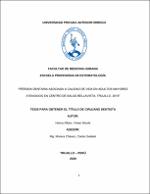Mostrar el registro sencillo del ítem
Pérdida dentaria asociada a calidad de vida en adultos mayores atendidos en centro de salud bellavista, Trujillo, 2019
| dc.contributor.advisor | Morera Chávez, Carlos Salatiel | |
| dc.contributor.author | Horna Alfaro, Vivian Nicole | |
| dc.creator | Horna Alfaro, Vivian Nicole | |
| dc.date.accessioned | 2020-03-04T13:58:46Z | |
| dc.date.available | 2020-03-04T13:58:46Z | |
| dc.date.issued | 2020 | |
| dc.identifier.uri | https://hdl.handle.net/20.500.12759/6018 | |
| dc.description.abstract | Determinar la asociación entre la pérdida dentaria y la calidad de vida en adultos mayores atendidos en el Centro de salud Bellavista, Trujillo 2019. Material y Método: EL estudio fue de corte transversal, se evaluó a 135 adultos mayores. Se empleó el test de GOHAI para determinar calidad de vida y Clasificación de Kennedy para determinar la pérdida dentaria. Resultados: De los adultos mayores que presentaron pérdida dentaria en el maxilar superior, el 48,8% presentó mala calidad de vida. El mayor porcentaje en el maxilar superior de pacientes con mala calidad de vida fue el edentulismo total (27,40%), seguido de Clase II (8,14%). Sí existe relación estadísticamente significativa entre las variables. Según la pérdida dentaria, se observó que el mayor porcentaje en el maxilar superior fue el edentulismo total (41,3%), seguido de la Clase III de Kennedy (14,80%); asimismo en el maxilar inferior fue el edentulismo total (24,4%), seguido de la Clase I (22.2%). Según la calidad de vida de los adultos mayores, se observó que el mayor porcentaje está en calidad de vida mala (48,80%), seguido de nivel moderado (43,70%) y finalmente nivel bueno (7,50%). Conclusión: Se concluyó que sí existe asociación entre la pérdida dental y la calidad de vida en adultos mayores. | es_PE |
| dc.description.abstract | To determine the association between dental loss and quality of life in older adults treated at the Bellavista Health Center, Trujillo 2019. Material and Method: The study was cross-sectional, 135 older adults were evaluated. The GOHAI test was used to determine the quality of life and the Kennedy Classification to determine dental loss. Results: of the older adults who had dental loss in the upper jaw, 48.8% presented poor quality of life. The highest percentage in the highest maximum of patients with poor quality of life was total edentulism (27.40%), followed by Class II (8.14%). There is a statistically significant relationship between the variables. According to the dental loss, it was lost that the highest percentage in the highest maximum was total edentulism (41.3%), followed by Kennedy Class III (14.80%); subsequently in the lower jaw was total edentulism (24.4%), followed by Class I (22.2%). According to the quality of life of the elderly, it was recorded that the highest percentage is in poor quality of life (48.80%), followed by a moderate level (43.70%) and finally a good level (7.50%) . Conclusion: It was concluded that there is an association between dental loss and quality of life in older adults. | en_US |
| dc.description.uri | Tesis | es_PE |
| dc.format | application/pdf | es_PE |
| dc.language.iso | spa | es_PE |
| dc.publisher | Universidad Privada Antenor Orrego | es_PE |
| dc.relation.ispartofseries | T_EST_628 | |
| dc.rights | info:eu-repo/semantics/openAccess | es_PE |
| dc.rights.uri | https://creativecommons.org/licenses/by/4.0/ | es_PE |
| dc.source | Universidad Privada Antenor Orrego | es_PE |
| dc.source | Repositorio Institucional - UPAO | es_PE |
| dc.subject | Pérdida Dentaria | es_PE |
| dc.subject | Adulto Mayor | es_PE |
| dc.title | Pérdida dentaria asociada a calidad de vida en adultos mayores atendidos en centro de salud bellavista, Trujillo, 2019 | es_PE |
| dc.type | info:eu-repo/semantics/bachelorThesis | es_PE |
| thesis.degree.level | Título Profesional | es_PE |
| thesis.degree.grantor | Universidad Privada Antenor Orrego. Facultad de Medicina Humana | es_PE |
| thesis.degree.name | Cirujano Dentista | es_PE |
| thesis.degree.discipline | Estomatología | es_PE |
| dc.subject.ocde | https://purl.org/pe-repo/ocde/ford#3.02.14 | es_PE |
| renati.type | https://purl.org/pe-repo/renati/type#tesis | es_PE |
| renati.level | https://purl.org/pe-repo/renati/level#tituloProfesional | es_PE |
| renati.discipline | 911016 | es_PE |
| dc.publisher.country | PE | es_PE |
Ficheros en el ítem
Este ítem aparece en la(s) siguiente(s) colección(es)
-
Estomatología [653]


